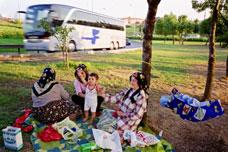Istanbul
dal 6/4/2004 al 30/5/2004
Segnalato da
Erik Gongrich
Cevdet Erek
Murat Sahinler
Osman Bozkurt
Secil Yersel
Yetkin Basarir
Aydan Murtezaoglu
6/4/2004
Istanbul
Ifa-gallery, Stuttgart
Since the 1990s, artists and exhibition curators have addressed subjects relating to urban structures and their alterations. The exhibition series UrbanreViews presents the individual views on and personal analyses of the megalopolis of men and women artists, architects and a sociologist who live there. They have investigated and documented how individual citizens find their way and make their home in a defined urban context, how people take possession of public spaces in their immediate environment, but also how individuals retreat from it into privacy.

URBANreVIEWS
Istanbul, the 2,500 year old city on the Bosporus, for centuries was repeatedly subject to cultural and architectural changes. From Byzantium via Constantinople to Istanbul – this city between Orient and Occident was fought over, destroyed, reconstructed, converted and extended. With the founding of the Republic of Turkey in 1923, Istanbul lost its status and function as the country's capital city and its population figure sank by almost forty per cent to one million. During the Great Depression and World War II, life in Istanbul was rather humble and tranquil. It was only during the 1970s that the city exploded, both geographically and demographically, to form one of the world's megacities of 13 million inhabitants, an above-average youthful population and a daily influx of over thousand migrants. The city now covers 5,500 square kilometres on both sides of the Bosporus. It grows and sprawls spontaneously and breathlessly, at times temporarily, in bits and pieces.
Industrial areas are relegated to the periphery and replaced by banking and office towers, service and shopping centres; urban expressways are even cut through the historic inner city and the middle and upper classes flee the city centre to live in new, security-guarded, residential estates while, almost overnight, the newcomers erect more and more new 'Gecenkondu' quarters and the historic city centre is transformed into an oriental Disneyland. Since the 1980s, the authorities have developed masterplans for preserving the old city core and redeveloping the city into an international trade and financial centre between East and West. Even before they can be publicly discussed, these plans are invariably overtaken by 'built reality'. And yet this city is 'functioning'. Istanbul's citizens organize their own lives, life in the city and sometimes the city itself according to their needs so that the megacity appears extremely vibrant and well organized despite problems like pollution and traffic jams.
Since the 1990s, artists and exhibition curators have addressed subjects relating to urban structures and their alterations. The exhibition series URBANreVIEWS presents the individual views on and personal analyses of the megalopolis of men and women artists, architects and a sociologist who live there. They have investigated and documented how individual citizens find their way and make their home in a defined urban context, how people take possession of public spaces in their immediate environment, but also how individuals retreat from it into privacy.
Erik Göngrich invites visitors to explore the city. His slide show 'Picnic City' offers views of the ninety per cent of the urban area beyond the historic city centre, the well-known, often visited and photographed districts of Pera, Galata and Sultanahmet, while Cevdet Erek's video installation 'The Second Bridge' focuses one of the two crossing points between Asia and Euope, between the Black Sea and the Mediterranean.
Addressing the appropriation of the public realm by the inhabitants, Seçil Yersel, with his photo series 'Luna Parks', and Yetkin Basarir, with his photos showing the semi-private use of dreary backyards, as well as the group Independent Fake Movement around the architect and urban designer Murat Sahinler reveal the absurdity of the officially laid-out public parks. Osman Bozkurt's video 'Automobile Park' documents, without commentary, how people risk their lives by using the green strips between and along motorways for football, barbecue picnics and sunbathing.
The exhibition moves from the public urban space via the privatized public space to private space as shown by the photographer Aydan Murtezaoglu with her serene, relaxed view of Istanbul, followed by Bülent Sangar's video which dramatizes the aggressiveness of individuals against everything outside the private sphere in both thrilling and chilling images.
Vasif Kortun, director of the Platform Garanti Contemporary Art Centre in Istanbul and curator of this exhibition, chose the works of artists whose approach to the subject of Istanbul is either poetic or documentary. They treat it from an urban design, sociological, communicative or aesthetic point of view, always, however, from a subjective perspective, from the exterior to the interior of urban life in Istanbul-the city of bridges and ferries, minibuses and urban motorways, Gecenkondu estates and office towers, mosques and markets.
Image: Osman Bozkurt: Auto-Park Highway-Parks of Istanbul, 2003
ifa Gallery Stuttgart
April 7 – May 30, 2004
opening: Tuesday, April 6, 2004, 6 p.m.
ifa Gallery Berlin
November 5, 2004 – January, 9 2005
opening: Thursday, November 4, 2004, 7 p.m.
A richly illustrated exhibition catalogue of approx. 64 pages with texts by Vasif Kortun and others will be available for 9 euros.
Ifa-gallery
Charlottenplatz 17 70173
Stuttgart



